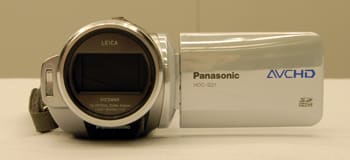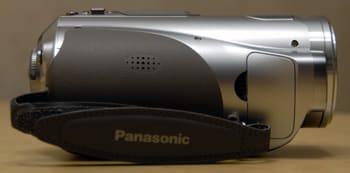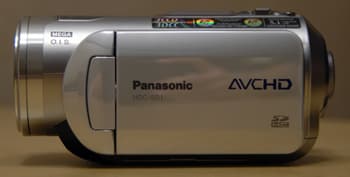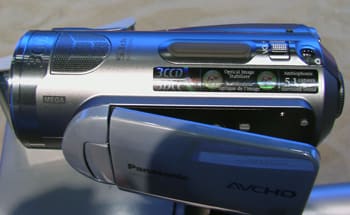Performance
http://media.pana3ccduser.com/media/HDC-SD1/beach_scene_full.jpghttp://media.pana3ccduser.com/media/HDC-SD1/beach_scene2.jpghttp://media.pana3ccduser.com/media/HDC-SD1/beach_scene3.jpghttp://media.pana3ccduser.com/media/HDC-SD1/beach_chairs_shells.jpg Skin tones are very real and colors are accurate. This is not surprising since Panasonic 3CCD camcorders are known for having excellent color reproduction. There seems to be some tendency for the camcorder to overexpose bright whites. You can see the whites are blooming a bit in the yellow and white striped towel behind the male model’s head. Interestingly enough, the zebra feature did not indicate the bright white areas were too bright. Also, the image resolution (picture detail) is not what I expected. I took frame grabs of the beach scene from a standard definition video shot with the Panasonic PV-GS400 and compared blown up sections from each camcorder of a portion of the frame containing the starfish and shells. Picture detail is essentially the same indicating that, although the frame is larger, the resolution appears to be only marginally better than standard definition. The overexposed whites and low picture detail may be due to the low pixel count on the CCDs or may be a result of the AVCHD encoding. At this point, I don’t have enough information to say for sure. I’ll have to wait until I can shoot a resolution chart and do more analysis. There is some distracting jitter in the image as the camcorder is panned. The jitter shows up when I play back the MPEG2 transport stream files on my laptop using Nero 7 Ultra Edition Enhanced and Cyberlink’s PowerDVD 7 Deluxe, both of which use adaptive de-interlacing. But, my laptop has a progressive display and the video is interlaced. Progressive displays and interlaced video often don’t play well together. I was unable to view the video using the HDMI or component video ports. I suspect those will look better on a large widescreen and I look forward to the opportunity when I can see the video from the HDC-SD1 on my HDTV. Panasonic has almost standardized optical image stabilization across its camcorder line. OIS is even more important to the video quality of the new AVCHD format as compared to DV since the AVCHD resolution is so much higher, thus amplifying any movement. The OIS seemed to work well on the HDC-SD1, which is good since this camcorder is so small and light any hand shake would make a mess of the image. Low Light PerformancePanasonic put three, ¼" CCDs in the HDC-SD1 and rates their low light sensitivity at 6 lux. As a point of reference, 6 lux is one full F-stop more sensitive than the 12 lux rating of the PV-GS500, last years top MiniDV camcorder. This should please many consumers who complain that camcorders with small CCDs don’t do well in low light. Panasonic was able to improve low light sensitivity by increasing the size of the CCDs while using fewer pixels than the PV-GS500 used to create the image. That means the pixels are larger and therefore can capture more light. It also means Panasonic was able to get increased sensitivity at a maximum aperture of F1.8. While I was unable to get really low light levels in the Panasonic display booth, I was able to discern a definite improvement in low light sensitivity in the dim areas around the booth as compared to my PV-GS400. The grain was low too, which made the image much cleaner than many other camcorders in these light levels.
Format
CompressionThe HCD-SD1 compresses its video using the H.264 Advanced Video Codec, better known as AVCHD, at 13 Mbps variable bitrate. The image is recorded in anamorphic widescreen, 1440x1080 pixels (1.333:1 pixel aspect ratio), and is interlaced. This frame size and scanning method are essentially the same as HDV, except HDV uses MPEG2 encoding instead of H.264. H.264 is a much more efficient codec than HDV, but its image quality fails to match HDV in our testing. We will know more when we can get an HDC-SD1 into our laboratory for more comprehensive testing. AVCHD was a co-development of Sony and Panasonic, announced this summer. Since then, Sony has managed to release four camcorders using the codec, for both DVD and HDD camcorders. Panasonic lagged a few months, but this camcorder was released simultaneously with the HDC-DX1, a DVD camcorder. AVCHD was a natural outcropping of two elements that consumers want: the quality of HD and the convenience of non-tape media. While the quality is currently not as good as HDV (a tape-based format) our conversations with hardware and software engineers tells us that the codec has enormous potential. The camcorders we have before us are very much a first generation. MediaThe HDC-SD1 uses secure digital high capacity (SDHC) flash memory cards. It comes with a 4 GB SDHC card to which it can record approximately 40 minutes in HF mode (13Mbps), 60 minutes in HN mode (9Mbps), and 90 minutes in HE mode (6Mbps). Standard SD cards from 256 MB to 2 GB can also be used, but the recording time is reduced to a fraction of what the 4 GB card can hold. EditingHD Writer version 1.0j software is included with the camcorder. It permits the transfer of the MPEG2 transport stream files from the SDHC card to a computer. However, any editing features will be rudimentary, at best. Editing AVCHD will also require a robust computer system with dual core processors. I found that it is possible to copy the MPEG Transport Stream (MTS) video files from the SDHC card to the computer through a simple file copy operation. This is much easier than trying to get the video off a DVD recorded on the HDC-DX1. I was never able to transfer video from the DVD. I suspect the software included with the HDC-DX1 is required to transfer it from DVD disk to the computer for editing. While several fronts have been made on AVCHD playback, there is yet to be a release for an NLE that can edit AVCHD natively. This has been a frustration for many consumers eager to adopt a non-tape based HD format, and it’s likely that we will see product releases within the year.
Tour

**The Front **The predominant feature on the front of the HDC-SD1 is its Leica Dicomar, 4 – 40mm, 12x zoom lens (equivalent to a 38.5 - 462.0mm 35mm lens). The lens is rated at F1.8 at 1x zoom that decreases to F2.8 as the lens is fully zoomed in to 12x. An automatic shutter-style lens cap protects the lens from harm when the camcorder is turned off or taken out of record mode. The lens hood accepts 43mm diameter filters. To the left of the lens is the photo flash for still pictures.

**The Right Side **The right side of the HDC-SD1 is very clean. At the front, behind a hard plastic cover are the USB 2 high speed and HDMI ports. Toward the center rear of the right side is the 20mm round speaker. The rear of the right side is covered with a soft-textured, silver plastic that seemed to be pretty comfortable. It was hard to tell as the camcorders were mounted on security poles that were tethered to the display stand, thus making it impossible for me to cradle the camcorder in my hand. Rounding out the right side is a standard Panasonic loop strap that can be adjusted through its Velcro fastener to most any hand.

**The Back **The back of the HDC-SD1 is its business end. Smack dab in the center of the back is the power/mode dial. A small detent on the right of the mode dial prevents the camcorder from being turned on inadvertently. Pressing the detent allows turning the mode dial out of power off and on to the three operating modes: video recording, playback and PC. The PC mode is used to connect the camcorder to a computer to transfer video and stills from the SDHC card. In the center of the mode dial is the record/pause pushbutton. I found the position of the record/pause button to be very practical for this mostly cylindrical camcorder. To the right of the mode dial is the joystick control for navigating the menus and activating or deactivating features. The joystick is also used to focus the lens in manual mode. Below the mode dial are buttons for Menu and delete (Trashcan). Pressing the Menu button activates and deactivates the menus on the LCD display. The delete button is used in playback mode to delete an individual clip. Each clip on the SDHC card gets its own icon and can be randomly accessed. If a clip is unwanted, the user selects it on the LCD display, presses delete…and away it goes, freeing up precious space on the SDHC card for more video. Below the mode dial is the battery compartment. A serious negative is that the battery on the HDC-SD1 is enclosed inside its compartment. That means that larger capacity batteries will be virtually impossible to use. Panasonic ships the camcorder with the VW-VBG130 battery that gives approximately 1 hour and 5 minutes of recording time. The battery cannot be changed if the camcorder is on a tripod.

**The Left Side **The left side shows a lot of the eye-candy design of this camcorder. The back of the LCD and its hinge mount are coated with an enamel-looking, pearlescent white coating. I think the design aesthetics of chrome, silver and pearlescent white will appeal particularly to women. The 3" widescreen, 211K pixel LCD panel is the most predominant feature of the HDC-SD1’s left side. The LCD display is very important to the user because lacking a viewfinder, the LCD is the only way to see what you are shooting. The LCD seemed very sharp with vibrant colors. The menus were particularly easy to read. However, I cannot say how it will hold up in bright sunlight. It is easy to wash out a LCD in bright lighting even when using the Power LCD function that considerably brightens the screen. I think LCD hoods or shades are going to be popular accessories for HDC-SD1 owners. The camcorder can be set to power on almost instantly when the LCD is opened. The speed of power up is an important feature of the HDC-SD1. The LCD panel can be rotated around its horizontal axis to permit viewing the scene when the camcorder must be positioned above or below eye level. Opening the LCD panel exposes the ports and controls inside the LCD cavity. Starting at the top left of the cavity is the reset button. To its right is the Power LCD button followed by the Auto-Manual-Focus switch to the far right. Below this top row of controls and behind a sliding door is the SDHC card slot. To the right of the card slot is the coaxial jack for the AC power cable. Directly below the SDHC card slot are three jacks. From the left, they are the proprietary audio-video (AV) multi-cable jack, component video jack and external microphone jack. AV standard definition analog and component video cables are provided with the HDC-SD1.

The TopThe top of the camcorder is artfully svelte…well, the whole darn camcorder is an artistic statement. Predominant at the front under a perforated cover that outlines the placement of each of the five microphone elements is the highly touted zoom 5.1 Dolby Digital surround microphone system. Panasonic demonstrated the zoom surround feature in their booth and it was impressive, indeed. Users will have more control over the microphone through the microphone level adjust feature that is accessed through the menus. Microphone level adjust permits turning off the automatic gain control and adjusting the mic (either internal or external) level to allow increased dynamic range such as might be preferred when recording an orchestra. To the rear of the microphones is a textured strip made of the same silver plastic material as on the right side handgrip. The user can rest fingertips on this strip while holding the camcorder in the right hand. I suppose this makes for a more secure grip, but it looks like more artistic statement to me. Behind the strip is the new zoom toggle rocker. Panasonic has taken the hint and substituted a very easy to use toggle instead of the old slider that we find problematic. The toggle has a very light feel and is easy to position for just the right slow crawling zoom. Kudos to Panasonic for this significant improvement. Behind the zoom toggle is the photo shot button. The photo shot button is positioned a little far back for me as the button was a long reach for my index finger. But, not as long a reach as the photo shot button on the HDC-DX1 which I absolutely couldn’t reach without affecting how I was pointing the camcorder.

Auto / Manual Controls
Picture & Manual Control*Automatic Control*The HDC-SD1 has fully automatic control over exposure and focus. The automatic functions appeared to operate smoothly and accurately in the shooting conditions offered by the Panasonic display booth. *

Overall Manual Control Users may opt to put the HDC-SD1 in manual and make adjustments to iris, gain, shutter and white balance. Panasonic has always offered a wide range of manual controls and continues to do so with the HDC-SD1. The joystick is used to select and adjust a parameter manually using the menu. Icons representing the parameter being adjusted and direction arrows are displayed on the LCD screen to aid adjustment. The user positions the joystick appropriately to change the parameter. *Zoom*The HDC-SD1 has a 12x optical zoom. Using the zoom toggle, the zoom speed can be adjusted from a barely noticeable crawl to a rapid rate that moves the lens through the entire zoom range in a matter of seconds. In addition to the optical zoom, digital enlargement of the image may be selected (digital zoom). Digital zoom ranges may be capped in two settings of up to 30x or 120x. *Focus *Automatic focus control is the preferred method of operation of the HDC-SD1. That is not to say than manual focus is not available…it is. And, the user can opt to use manual focus assist when focusing manually. Manual focus assist opens a small window in the middle of the LCD screen, very similar to a picture-in-picture television feature (click here to see the feature in action), that zooms in on the image to show the focus area in more detail. I found it was better than using the LCD alone. However, focus changes on the zoomed image are subtle and I highly doubt would be discernable in bright light. This is where an electronic viewfinder is indispensable. *Exposure & Aperture *The automatic exposure range is from F1.8 to F16 at a shutter speed of 1/60 second. Automatic exposure controls appeared to operate satisfactorily in the lighting conditions I was afforded in the display booth. *Shutter SpeedShutter speed for automatic recording in video mode is 1/60 second. Shutter may be adjusted in video record mode from 1/60 to 1/8000 second. In still photo mode, shutter may be adjusted from 1/60 to 1/8000, and may be adjusted in progressive photo shot mode from 1/60 to 1/500. White Balance*The HDC-SD1 automatically adjusts color contributions from the red, green and blue CCDs that make white objects look white when recorded. The automatic white balance control appeared to function correctly. Manual control over white balance is available via the menus. *Gain*Gain (electronic amplification of the image brightness) is employed automatically when the iris reaches its maximum aperture of F1.8 and correct exposure levels cannot be maintained. The HDC-SD1 will boost image brightness up to 18 dB (three f-stops) to maintain the correct exposure. *Other Manual ControlsThis camcorder is all about style and design and lacks any additional manual controls.
Still Features
**Still Features **The HDC-SD1 shoots 1920x1080 stills (2.1 Megapixels) to the SDHC card.
Handling and Use
Ease of UseThe HDC-SD1 is basically a stylish, point and shoot camcorder. HandlingWell, it is certainly light. The cylindrical body is grasped easily in a woman’s hand which is where I suspect the majority of these camcorders will wind up.

*The battery is enclosed, which may certainly prove
to be a detriment to battery life. **Menu*The menus are very readable. Colors are vivid and paging through the menu options is quite logical. While there is a slightly different look to the menu of past Panasonic camcorders, the orientation is almost identical to the those of the past several years.

LCD and ViewfinderThe LCD is sharp, bright and colorful. It needs to be since there is no viewfinder on the HDC-SD1. Using this camcorder in bright sunlight is likely to require a LCD hood which will seriously diminish the style points one would expect to accumulate using it at a Malibu pool party.
Audio / Playback / Connectivity
AudioAudio is a bright spot in this mostly stylistic camcorder. The Dolby Digital 5.1 surround microphones, with zoom function, sound great on an appropriate sound system. The optional microphone manual level adjust makes using external microphones manageable. However, having no headphones jack requires hanging a lot of bulky AV cables and adapters off this little work of art just to hear what you are recording. I just can’t see this being done at a dinner party. PlaybackVideo can be played back to appropriate displays using the AV, component video and HDMI cables. ConnectivityThere are output ports for USB 2 high speed, HDMI, component video, and analog audio-video (AV). There is a 1/8 in., unbalanced stereo phone jack input for a low impedance microphone.
Other Features
**Other Features
**The HDC-SD1 offers zebras (overexposure indicators), color bars for calibrating the color editing parameters, and manual focus assist. A new feature on Panasonic camcorders this year is Guide Lines which aid in aligning the camcorder’s frame to the scene. There are up to three options for Guide Lines on the HDC-SD1: horizontal, Grid 1 and Grid 2. Horizontal superimposes three horizontal lines over the scene on the LCD display. Grid 1 superimposes a grid of 9 boxes over the scene. And, Grid 2 superimposes a grid of 60 boxes over the scene. These Guide Lines help the shooter align the camcorder’s frame to the scene for best composition. **
**
Comparisons / Conclusion
**Conclusion**If you travel in high society and want to make a statement, then this is the camcorder for you. It looks like a camcorder that millionaires would choose – small, sleek and stylish — and the video is not bad if you don’t look at it closely. I suspect it is targeted for society moms who can appreciate a designer camcorder. However, video enthusiasts would be better off sticking with HDV for a recording format. The video quality is better and the prices are lower.
Meet the tester

Guy Bruner
Editor
Guy Bruner is a valued contributor to the Reviewed.com family of sites.
Checking our work.
Our team is here for one purpose: to help you buy the best stuff and love what you own. Our writers, editors, and lab technicians obsess over the products we cover to make sure you're confident and satisfied. Have a different opinion about something we recommend? Email us and we'll compare notes.
Shoot us an email